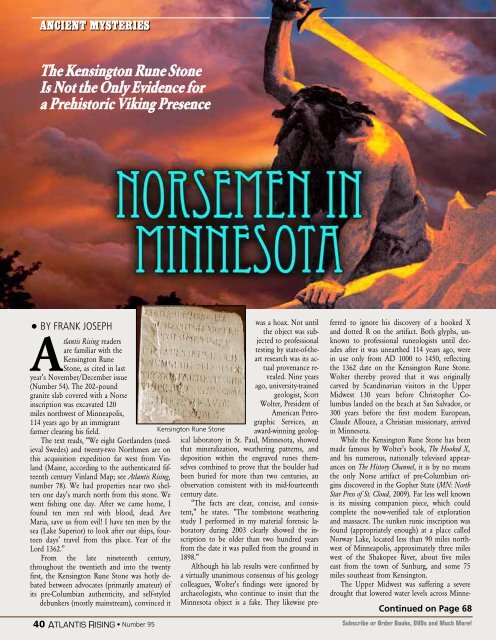Do We Know What We Think We Know About ... - TheUFOStore.com
Do We Know What We Think We Know About ... - TheUFOStore.com
Do We Know What We Think We Know About ... - TheUFOStore.com
Create successful ePaper yourself
Turn your PDF publications into a flip-book with our unique Google optimized e-Paper software.
ANCIENT MYSTERIES<br />
The The Kensington Kensington Rune Rune Stone Stone<br />
Is Is Not Not the the Only Only Evidence Evidence for for<br />
a a Prehistoric Prehistoric Viking Viking Presence<br />
Presence<br />
• BY FRANK JOSEPH<br />
Atlantis Rising readers<br />
are familiar with the<br />
Kensington Rune<br />
Stone, as cited in last<br />
year’s November/December issue<br />
(Number 54). The 202–pound<br />
granite slab covered with a Norse<br />
inscription was excavated 120<br />
miles northwest of Minneapolis,<br />
114 years ago by an immigrant<br />
farmer clearing his field.<br />
The text reads, “<strong>We</strong> eight Goetlanders (medieval<br />
Swedes) and twenty-two Northmen are on<br />
this acquisition expedition far west from Vinland<br />
(Maine, according to the authenticated fifteenth<br />
century Vinland Map; see Atlantis Rising,<br />
number 78). <strong>We</strong> had properties near two shelters<br />
one day’s march north from this stone. <strong>We</strong><br />
went fishing one day. After we came home, I<br />
found ten men red with blood, dead. Ave<br />
Maria, save us from evil! I have ten men by the<br />
sea (Lake Superior) to look after our ships, fourteen<br />
days’ travel from this place. Year of the<br />
Lord 1362.”<br />
From the late nineteenth century,<br />
throughout the twentieth and into the twenty<br />
first, the Kensington Rune Stone was hotly debated<br />
between advocates (primarily amateur) of<br />
its pre-Columbian authenticity, and self-styled<br />
debunkers (mostly mainstream), convinced it<br />
40 ATLANTIS ATLANTIS RISING RISING • Number 95<br />
was a hoax. Not until<br />
the object was subjected<br />
to professional<br />
testing by state-of-theart<br />
research was its actual<br />
provenance revealed.<br />
Nine years<br />
ago, university-trained<br />
geologist, Scott<br />
Wolter, President of<br />
American Petrographic<br />
Services, an<br />
award-winning geological<br />
laboratory in St. Paul, Minnesota, showed<br />
that mineralization, weathering patterns, and<br />
deposition within the engraved runes themselves<br />
<strong>com</strong>bined to prove that the boulder had<br />
been buried for more than two centuries, an<br />
observation consistent with its mid-fourteenth<br />
century date.<br />
“The facts are clear, concise, and consistent,”<br />
he states. “The tombstone weathering<br />
study I performed in my material forensic laboratory<br />
during 2003 clearly showed the inscription<br />
to be older than two hundred years<br />
from the date it was pulled from the ground in<br />
1898.”<br />
Although his lab results were confirmed by<br />
a virtually unanimous consensus of his geology<br />
colleagues, Wolter’s findings were ignored by<br />
archaeologists, who continue to insist that the<br />
Minnesota object is a fake. They likewise pre-<br />
Kensington Rune Stone<br />
ferred to ignore his discovery of a hooked X<br />
and dotted R on the artifact. Both glyphs, unknown<br />
to professional runeologists until decades<br />
after it was unearthed 114 years ago, were<br />
in use only from AD 1000 to 1450, reflecting<br />
the 1362 date on the Kensington Rune Stone.<br />
Wolter thereby proved that it was originally<br />
carved by Scandinavian visitors in the Upper<br />
Midwest 130 years before Christopher Columbus<br />
landed on the beach at San Salvador, or<br />
300 years before the first modern European,<br />
Claude Allouez, a Christian missionary, arrived<br />
in Minnesota.<br />
While the Kensington Rune Stone has been<br />
made famous by Wolter’s book, The Hooked X,<br />
and his numerous, nationally televised appearances<br />
on The History Channel, it is by no means<br />
the only Norse artifact of pre-Columbian origins<br />
discovered in the Gopher State (MN: North<br />
Star Press of St. Cloud, 2009). Far less well known<br />
is its missing <strong>com</strong>panion piece, which could<br />
<strong>com</strong>plete the now-verified tale of exploration<br />
and massacre. The sunken runic inscription was<br />
found (appropriately enough) at a place called<br />
Norway Lake, located less than 90 miles northwest<br />
of Minneapolis, approximately three miles<br />
west of the Shakopee River, about five miles<br />
east from the town of Sunburg, and some 75<br />
miles southeast from Kensington.<br />
The Upper Midwest was suffering a severe<br />
drought that lowered water levels across Minne-<br />
Continued on Page 68<br />
Subscribe or Order Books, DVDs and Much More!


